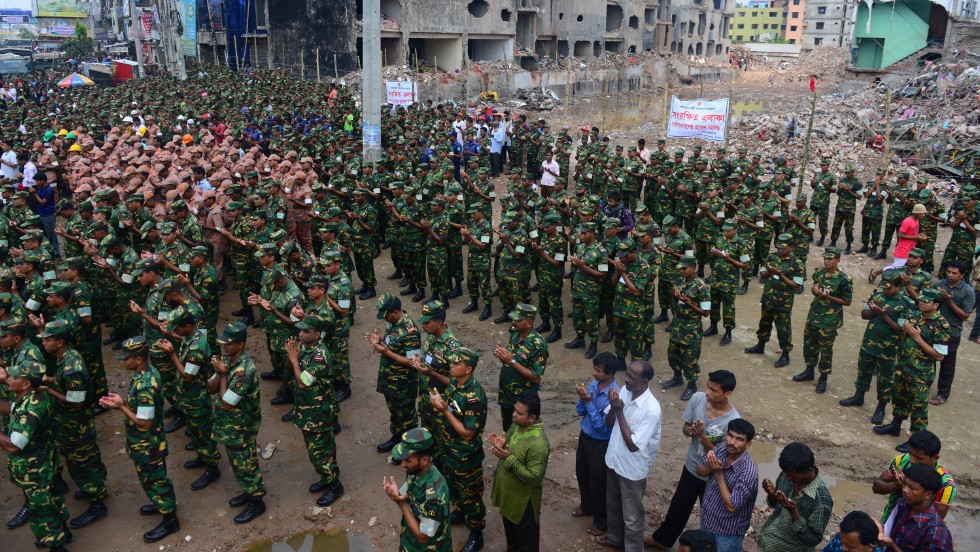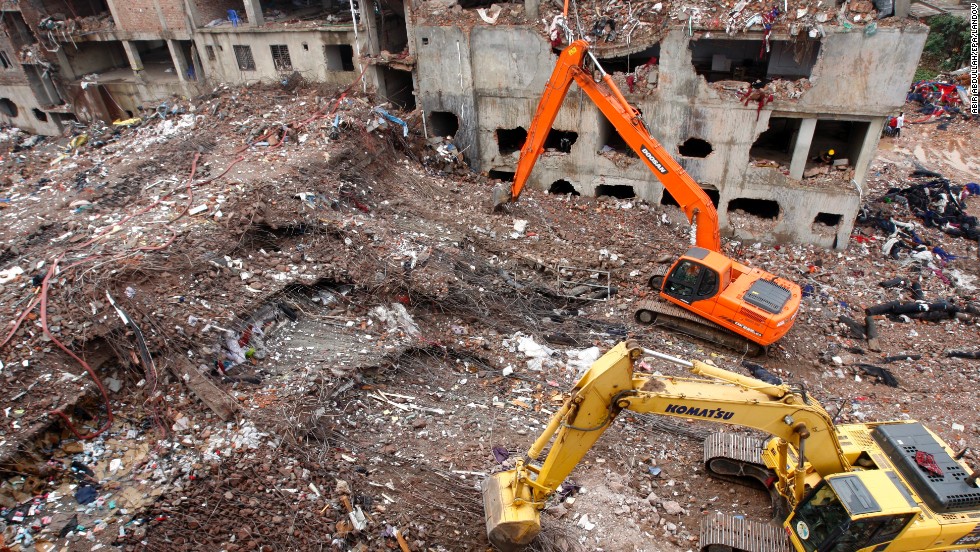Story highlights
- The death toll has climbed to 378
- Police: The building's owner was trying to flee the country
- A man pleads to be rescued for days but then dies
Seventy-two hours.
In any calamity, the first 72 hours are critical. The chances of finding survivors dwindle significantly after that.
But in the Dhaka suburb of Savar, Sunday marks day four of a catastrophic building collapse. And miraculously, from the rubble of mangled metal and cement, the living continue to emerge.
Authorities rescued four people from the crumbled nine-story building Sunday morning -- and rumors flew that more have been spotted in a small pocket in the sandwiched structure.
If true, the new survivors will add to the growing total of people pulled out alive, which already stands at more than 2,400.
Buoyed by hope, authorities have decided to delay moving from a rescue operation to a recovery one.
The heavy machinery they brought in to tear through the large slabs of concrete sit idle for the moment as rescuers -- a combination of troops and volunteers -- claw through the dirt and debris with bare hands or with rusty saws.
"It's been made clear by the authorities that the highest priority would be to find survivors," said Morshed Ali Khan, a reporter with the Daily Star newspaper. "Machinery is the last option."
The death toll stands at 378. No one knows for sure how many remain unaccounted for. More than 600 by some counts.
Authorities have arrested six people: three factory owners, two government engineers and the owner of the building, Sohel Rana -- a local-level leader of the ruling Awamil League party. He had gone into hiding soon after the collapse, and police said he was trying to flee the country.
A deadly lure
The commercial building housed five garment factories, several shops and a bank.
The collapse occurred Wednesday morning, a day after cracks appeared in the structure. It led the bank to order its employees not to report for work, and the shops were closed because of a strike.
But garment workers were told to come in despite their concerns that the building's structure was not sound.
Savar, about 45 kilometers (27 miles) from the capital, Dhaka, is home to many of the country's more than 4,000 garment factories.
Bangladesh is among the top exporters of clothes to the United States and Europe; the industry accounts for 77% of its exports.
And while deadly accidents and deplorable conditions at garment factories are all too common, the pay is still a lure for many in this impoverished country, where the minimum wage is $38 a month.
The last major building collapse in Bangladesh occurred in 2005, in the same area as Wednesday's, and killed more than 70.
In November, a fire at Tazreen Fashions Factory in another suburb of Dhaka killed at least 112 people.
And now this.
The daily rhythm
At this disaster zone, the pungent stench of death permeates the air.
Rescue workers cover their faces with T-shirts to escape the smell of decaying flesh.
But it often proves too much. They keel over and vomit.
Each body pulled out takes an emotional toll. Each more heart-wrenching than the one before.
Over the weekend, rescuers found an outstretched hand sticking out from the rubble. In the man's clenched fist, a crumpled piece of paper.
"Dear father and mother," it read. "Please forgive me that I can't buy your medication anymore. Dear brother, please tend to our parents."
The note then named the victim's village. "Please send my body there."
In another case, workers found two bodies covered in dust. A man and a woman holding each other in an embrace as they awaited death.
Khan, the reporter, recalled coming across a man trapped from his waist down under a heavy slab of concrete.
Awakened by the flash from photographers' cameras, he pleaded to be rescued.
"Brothers, please save me! Please save me!" he urged.
For three days, he pleaded.
But there was little anyone could do. The slab proved too heavy to lift off him, Khan said.
The man died.
But the miracles keep workers going.
A woman was pulled out after more than 45 hours. She had been trapped under a machine. After failing to pull her hand out, rescue workers were forced to saw it off. But she lived.
Another woman who went into labor and gave birth while trapped was also pulled out alive. Her baby also lived.
The desperate wait
Outside the perimeter of the rescue area, family members wait, holding hands, mouthing silent prayers, holding pictures of missing relatives.
Gone are the wailing and crying that punctuated the air the first few days after the building crumbled.
As hope died, so did the tears.
Each time a body is pulled out -- dead or alive -- there's a desperate dart toward ambulances.
It ends in a wild cheer in some cases. But in most, heaves and sobs follow.
"The whole situation is so helpless," Khan said. "They don't know how to lift these slabs. They don't have the right equipment."
The unapproved plan
Disaster Management Minister Abul Hasan Mahmood Ali said Sunday the building was not built up to code.
It was erected on a wetland, and engineers used substandard materials for construction.
Furthermore, he said, the government never approved the plan.
The revelations are sure to fuel the outrage that's been burning for days in the country following the collapse.
But those at the scene say finger-pointing can come later.
There are people still in the rubble. It's been more than 100 hours.
And time is not on their side.













































































































































































